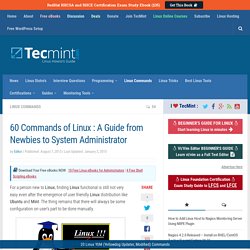

How To : Install and Use screen in Linux. Ubuntu Tutorials - Page 4 of 85 - Enhancing your Ubuntu experience! If you’ve enjoyed this blog, please consider picking up a copy of my Ubuntu book, Instant Ubuntu.

Thanks for visiting! The following security announcement applies to firefox and xulrunner. If you have firefox and xulrunner installed, please see below for details on the vulnerability and instructions on patching your system: Several flaws were discovered in […] The following security announcement applies to firefox and xulrunner. If you have firefox and xulrunner installed, please see below for details on the vulnerability and instructions on patching your system: Several flaws were discovered in the browser engine of Firefox. 20 Advanced Commands for Linux Experts. Thanks for all the likes, good words and support you gave us in the first two part of this article.

In the first article we discussed commands for those users who have just switched to Linux and needed the necessary knowledge to start with. 20 Useful Commands for Linux Newbies In the second article we discussed the commands which a middle level user requires to manage his own system. 20 Advanced Commands for Middle Level Linux Users What Next? 41. Ifconfig is used to configure the kernel-resident network interfaces. Check Active Network Interfaces Check All Network Interfaces Display details of All interfaces including disabled interfaces using “-a” argument. Disable an Interface [avishek@tecmint ~]$ ifconfig eth0 down Enable an Interface [avishek@tecmint ~]$ ifconfig eth0 up. 20 Advanced Commands for Middle Level Linux Users. You might have found the first article very much useful, this article is an extension of the 20 Useful Commands for Linux Newbies.

The first article was intended for newbies and this article is for Middle-Level-User and Advanced Users. Here you will find how to customise search, know the processes running guide to kill them, how to make your Linux terminal productive is an important aspect and how to compile c, c++, java programs in nix. 21. Command: Find Search for files in the given directory, hierarchically starting at the parent directory and moving to sub-directories. root@tecmint:~# find -name *.sh . Note: The `-name‘ option makes the search case sensitive. Root@tecmint:~# find -iname *.SH ( find -iname *.Sh / find -iname *.sH) . root@tecmint:~# find -name *.tar.gz /var/www/modules/update/tests/aaa_update_test.tar.gz . Note: The above command searches for all the file having extension ‘tar.gz‘ in root directory and all the sub-directories including mounted devices. 22. Switching From Windows to Nix or a Newbie to Linux - 20 Useful Commands for Linux Newbies. So you are planning to switch from Windows to Linux, or have just switched to Linux?

Oops!!! What I am asking! For what else reason would you have been here. From my past experience when I was new to Nux, commands and terminal really scared me, I was worried about the commands, as to what extent I have to remember and memorise them to get myself fully functional with Linux. No doubt online documentation, books, man pages and user community helped me a lot but I strongly believed that there should be an article with details of commands in easy to learn and understand language.These Motivated me to Master Linux and to make it easy-to-use. 1.
The command “ls” stands for (List Directory Contents), List the contents of the folder, be it file or folder, from which it runs. root@tecmint:~# ls Android-Games Music Pictures Public Desktop Tecmint.com Documents TecMint-Sync Downloads Templates The command “ls -l” list the content of folder, in long listing fashion. 60 Commands of Linux : A Guide from Newbies to System Administrator. For a person new to Linux, finding Linux functional is still not very easy even after the emergence of user friendly Linux distribution like Ubuntu and Mint.

The thing remains that there will always be some configuration on user’s part to be done manually. Just to start with, the first thing a user should know is the basic commands in terminal. Linux GUI runs on Shell. When GUI is not running but Shell is running, Linux is running. If Shell is not running, nothing is running. And we have described all of the above basic computational task in our First Article.
This was the first article of this series. What after these initial commands? This Second Article was again highly appreciated by the readers of Tecmint.com. After providing the users with the glimpse of Commands used by a Middle Level User we thought to give our effort in a nice write-up for a list of command used by an user of System Administrator Level. There are too long lists of commands available in Linux. How to share folders between Windows and Ubuntu using VMware Player.
So now you’ve got Ubuntu installed in a Virtual Machine, you’ll probably find it useful to have a shared folder with the Windows host OS.

Create a folder in your Windows file system that you want to use as the share. Make sure it’s in a location where your user account has full access rights. I’ve created one in My Documents as it will also be backed up by my Mozy Home accountPower down the VM shutting down UbuntuSelect your VM in VMware Player and click Edit virtual machine settings In the Options tab click Shared Folders in the left hand pane Click Always enabled in the right and pane and click Add…This will take you into the “Add Shared Folder Wizard” Click Next and follow the prompts selecting the folder you created in Step 1Also name the share – this is the name that the folder will have in UbuntuYou will come back to the Settings screen with your share added Share folder permissions across Ubuntu Virtual Machine & Windows Host.